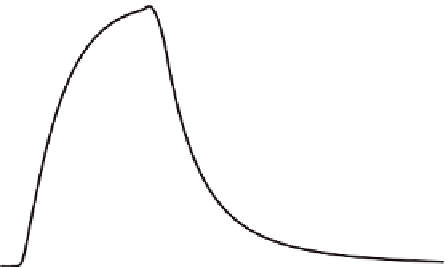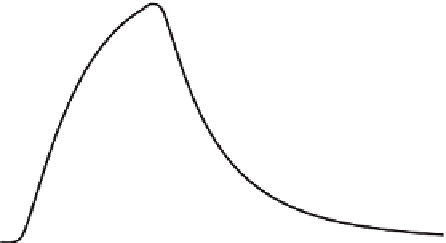Agriculture Reference
In-Depth Information
layering sequence was reversed (R2 → R1) and the reactive layer (R2) was
the top layer. Therefore, for the linear adsorption case, one concludes that the
order of soil stratification or layering sequence fails to influence solute BTCs,
consistent with those reported earlier by Shamir and Harleman (1967) and
Selim, Davidson, and Rao (1977) for systems with two or more layers. Based
on these results, a layered soil profile could be regarded as homogeneous
with an average retardation factor used to calculate effluent concentration
distributions. An average retardation factor
R
for
N
-layered soil can simply
be obtained from:
N
1
∑
R
=
RL
(9.7)
i
i
L
i
=
1
BTCs identical to those in Figure 9.2 were obtained using the solution to
the convection-dispersion Equation 9.7 presented by van Genuchten and
Alves (1982) and an average retardation factor. This averaging procedure
(Equation 9.7) can also be used to describe the BTCs from a soil profile com-
posed of three or more layers. However, if solute distribution within the pro-
file is desired, the use of an average retardation factor is no longer valid and
the problem must be treated as a multilayered case.
9.4.2 Nonlinear Freundlich Adsorption
Simulated BTCs of solutes from a two-layered soil system with one as a
nonlinear (Freundlich) adsorptive layer are given in Figure 9.3.
K
d
is the
Nonlinear Adsorption
1.0
b=0.5
R1
R2
0.8
0.7
0.9
R2
R1
Brenner no = 2
0.6
0.4
0.2
1.25
1.5
0.0
0
4
8
12
16
FIGURE 9.3
Simulated breakthrough results for a two-layered soil column under different layering orders
(R1 → R2 and R2 → R1). Here R1 is a nonreactive layer and R2 is a reactive layer with nonlin-
ear adsorption, with
b
values (Equation 9.11) of 0.5, 0.7, 0.9, 1.25, and 1.5. The Brenner number
B
used was 2.




























































































































































































Search WWH ::

Custom Search